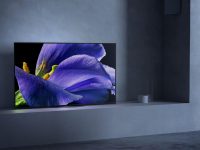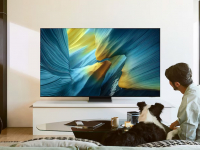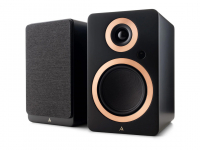
The phrase ‘vinyl revival’ is easily the most overused in hi-fi circles these days, but its ubiquity underpins just how popular vinyl records, and the turntables that play them, have become in the past five or so years.
Playing a huge part in the turntable and playback aspect of this comeback have been Austrian-based manufacturer, Project. Known for their unique approach to turntable design, worldwide sales have been so strong that Project’s design quirks and idiosyncrasies have practically become the norm; a whole generation of record lovers now accustomed to the minimalist styling and manual operation that is the hallmark of a Project turntable.
Project have long been a favourite of the hi-fi media, too. Today’s review subject, the Essential III, is hoping to follow in the footsteps of no fewer than eleven (!) of its older siblings to pick up a 5-star review in What Hi-Fi? Magazine, including both previous iterations in the ‘Essential’ series. No pressure, then!
Given that it IS the third generation of such a popular deck, it’s unlikely to think that Project would completely start again from scratch, and the updates made to the Essential III are incremental rather than wholesale, but that’s not exactly a terrible thing. From a design point of view, Project have kept things reasonably minimalist again, with the Essential III’s only ‘bling’ coming in the form of a new choice of gloss finishes (red, white or black), and its name printed in the bottom right corner of the turntable. Things like the anti-vibration feet and the belt that sits on the outside of the platter are still here from previous decks, as are the anti-skating weights.

There wasn’t a whole lot wrong with its predecessor but now with an acrylic platter and upgraded cartridge, the Project Essential III is better than ever.
The platter is the main area to receive an upgrade, with Project opting to use an upgraded version of their Acryl-IT E unit seen on their other turntables. Previous entries in the Essential range have used the MDF for the platter, the same material that the rest of the deck is built from. The Acryl-IT E platform is more acoustically inert, greatly helping to reduce resonance, and therefore aiding musical performance. Project have put a huge amount of research into making this one of the smoothest operating platters out there, with a stainless steel bearing and Teflon-lined underside making for a super slick performance.
Another area to see a welcome upgrade is the cartridge. Now fitted with an Ortofon OM10, rather than the cheaper OM 5 E of the Essential II, the ‘III is sporting one of the best cartridges at its price point and beyond. Project have opted to keep the 8.6″ straight tonearm used in some of their other decks, and this aluminium-built arm continues to offer great performance. Project stress that a number of high-end cartridges are compatible with this arm, but the OM10 offers superb sound quality, and its likely that users will want to stick with this excellent model throughout.
As with most of Project’s decks, the Essential III has no phono-stage built in, so the end user will need to have one in their amplifier or use a separate outboard unit, such as Project’s Phonobox. Not including a phono-stage is no oversight, with these vital electronics always best kept away from the turntable itself, thus reducing chances of electrical interference, so Project lose no marks for this. The phono-stage (or pre-amp) is also another part of the hi-fi chain that can be upgraded, with plenty of options out there for improving sound quality. We opted to use Cambridge’s CP1 for our listening test and found that the pair worked very well together. Cambridge’s CXA60 amplifier was also brought into action, with the Dali Zensor 3 speakers making up the set.
Radiohead’s In Rainbows album was first up, and it was obvious that Project had hit the proverbial nail right on its head. Opener, 15 Step is about as good a way to start an album as you’ll find, the track a melting pot of ideas, all of them, in typical Radiohead fashion, blending together perfectly. The scratchy drum patterns that kick things off had plenty of detail to them, whilst Thom Yorke’s vocal was satisfyingly weighty. Colin Greenwood’s superb bass playing could be followed easily on the Essential III, and the rest of the band sat very nicely indeed in this well-balanced track. As the track begins to sprint towards its conclusion, the gritty drums are brought back to the front of the mix, underpinning a swirling, slightly wonky melody. All of the small details and nuances were audible, and the Project’s full-bodied presentation of the sound made for a thoroughly enjoyable listen.
Switching to Philip Glass’ Solo Piano, the Project showed itself to be hugely capable at tone and timbre of a untreated instrumentation. The haunting melody of Metamorphosis One always puts hairs on end, and the playing here really sells it. The Essential III gave weight again to the piano, with a wonderful tone to the lower registers.
All told, the Essential III proved a resounding success. The upgrades that Project had fitted took performance up a clear level from the Essential II, with a noticeable widening of the soundstage, and a fuller, more lifelike sound than its predecessor. As far as generational shifts go, the Essential III has been a hugely worthwhile one, offering a noticeable leap in sound quality whilst retaining the ‘house sound’ of all Project turntables. An easy recommend – call your local Richer Sounds store to arrange a demo!
Shop for Turntables with Richer Sounds.
Author: Chris, Liverpool store






Hi …I bought essential III turntable and I don’t know how set up this. .. can U help me set up this when I come to your shop with my turntable .. thx for answer
Hello Matus,
Absolutely. Simply pop-in to your local branch where you bought it, or give them a call.
http://www.richersounds.com/storefinder